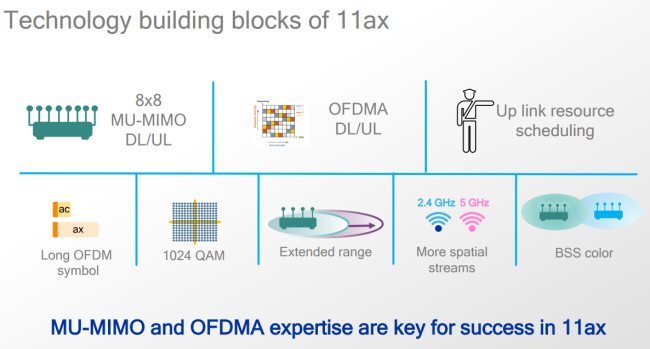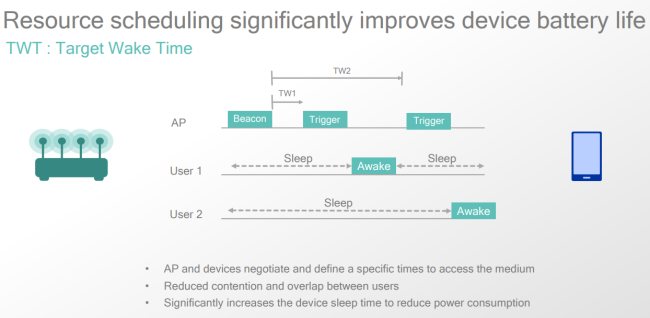What is WiFi 6 – The next generation of WiFi
Wifi 6 – The next standard for wireless LANs, IEEE 802.11ax, has been conceived to transmit data faster, to better allocate bandwidth among several devices connected to a WiFi network and to more reliably deliver high-bandwidth applications (such as video streaming) than its predecessor, 802.11ac, also known as WiFi 5.
The new naming standard
The 802.11ax specification, also known as ‘high-efficiency wireless’, will be commonly referred to and marketed as WiFi 6.
This is a new naming standard set by the Wi-Fi Alliance®, with previous generations now being retroactively labelled as WiFi 5 (802.11ac) and WiFi 4 (802.11n). This new labelling convention will appear on devices as shown in the image below.

This naming scheme is aimed at making it simpler for final consumers to recognize which of the IEEE 802.11 standards each WiFi device supports.
Faster data transfer speeds
WiFi 6 will have a single-user data rate that is about 40% faster than 802.11ac by virtue of a more efficient data encoding, resulting in a higher throughput: more data is packed into the same radio waves, and the chips that encode and decode the signals will increasingly get more powerful and will be able to handle the additional work.
The new standard also improves the performance on 2.4GHz networks that, despite the large investments of the industry on the 5GHz band to reduce interferences, is still better at penetrating physical obstacles.
WiFi 6’s predecessor, 802.11ac, only uses bands in the 5GHz spectrum; the new standard operates across both frequencies and will eventually expand this spectrum to include bands in 1GHz and 6GHz when they become available.
Better performance in dense environments
WiFi performance tends to get worse in crowded locations, such as stadiums, airports, malls and offices, where many WiFi enabled devices are connected to the network at the same time.
The new WiFi 6 incorporates many new technologies to overcome this issue, and according to Intel, it will improve each user’s average speed by at least four times in congested areas.
WiFi 6 can divide a wireless channel into a large number of subchannels, and each of these subchannels can carry data intended for a different device. This is achieved through the Orthogonal Frequency Division Multiple Access (OFDMA), a modulation scheme which allows for resource unit allocation and will boost capacity, reduce latency and improve efficiency by allowing as many as 30 users at once to share the same channel. This technology is not a part of WiFi 5, which has regular OFDM; OFDMA is compared as a multi-user version of OFDM.
The new wireless standard has also an improved version of multi-user or MU-MIMO. Wi-Fi 5 Wave 2 introduced Multi-User MIMO, but it only supports four simultaneous connections on downstream (one on upstream). Wi-Fi 6 will instead be able to handle eight streams of data in either uplink or downlink, offering four times the maximum theoretical throughput of Wi-Fi 5 and supporting more users at once.

Image Source: Qualcomm
Extended battery life for client devices
The new Target Wake Time (TWT) feature enables access points to tell to connected devices when and how frequently they have to “wake up” to send or receive data, reducing power consumption and improving spectral efficiency. This technology will be very useful for both mobile and IoT devices, allowing them to effectively increase their sleep time and consequently extend their battery life.
Target Wake Time, in addition to saving power on the client device side, also enables wireless access points and devices to define and negotiate specific times to access the medium, reducing contention and overlap between users.

Image source: Qualcomm
When will we get WiFi 6?
While some routers already advertise “802.11ax technology” and many products supporting WiFi 6 were presented during CES 2019, 802.11ax WiFi won’t be finalized until the end of 2019. There also aren’t any WiFi 6 client devices available yet, so so these routers won’t bring any benefits to consumers before the transition is done: indeed, both the sender and the receiver need to support the latest generation of WiFi to gain the advantages.
Related articles:
https://www.classichotspot.com/blog/ces-2019-four-interesting-innovations-for-the-wireless-devices-industry/

